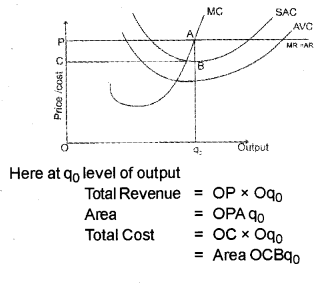Kerala Plus Two Microeconomics Chapter Wise previous Questions Chapter 4 The Theory of The Firm Under Perfect Competition
Question 1.
Correct the following statements, if necessary: (MARCH-2010)
Statement I : Liquidity trap is the situation in which speculative demand for money is infinitely elastic.
Statement II : The imposition of a unit tax shift the supply curve of a firm to the left.
Statement III : The profit level that is just cover the explicit cost and opportunity cost is supernormal profit.
Answer:
Statement I : No correction
Statement II : No correction
Statement III : The profit level that is just cover
the explicit cost and opportunity cost is normal profit
Question 2.
There are three identical firms in a market. The following table shows the supply schedule of a firm : (MARCH-2010)
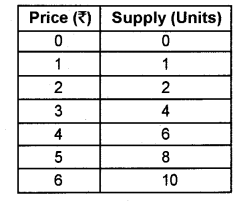
1) Define market supply
2) Compute market supply schedule
3) Draw market supply curve
Answer:
1) The output level that firms in the market produce in aggregate, corresponding to different values of market prices.
2)
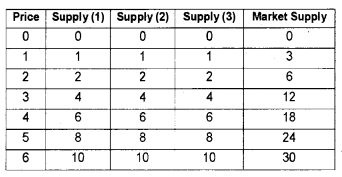
3) Draw a market supply curve that slopes upwards corresponding to the above values.
Question 3.
Any factor that affects a firm’s marginal cost curve is of course a determinant of its supply curve”, there are three factors – determining the supply curve of a firm. Identify them. (MAY-2010)
Answer:
Factors determining the supply curve of a firm are :
Technical progress
Input prices
Unit tax
Question 4.
Mr. Kameth is a textile mill owner. He is facing challenges in production and marketing screnario. The situations he faced are given in column A and corresponding outcomes in marginal cost and supply of output are given in column B and C. Match A with B and C. (MARCH-2011)
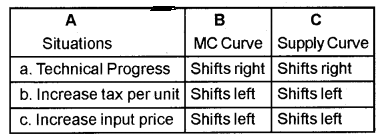
Answer:
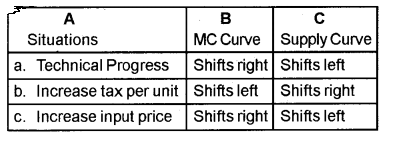
Question 5.
Under perfect competition a firm’s profit in the short run is maximized when 3 conditions are satisfied. (MARCH-2011)
a) Discuss the 3 conditions.
b) From the following schedule, suggest profit
maximizing level of output in the short run if price is ₹10.

Answer:
a 1) MC must be equal to MR
2. MC must cut MR from below
3. Slope of MC must be greater than slope of MR.
b)
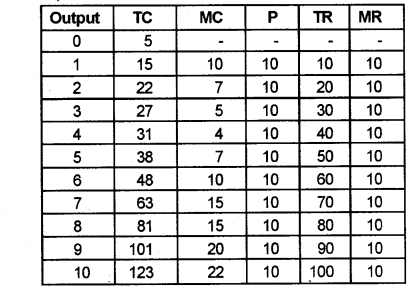
c) Since MC = MR = 10 at 6th unit of output, the profit maximising level of output is 6 units.
Question 6.
In the following diagram, at points E and E1 MC and MR are equal. Among these, which point do you consider as producer’s equilibrium? Justify your answer. (MARCH-2012)
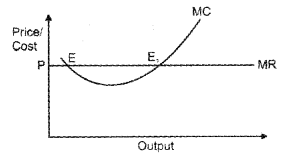
Answer:
In this diagram, producer’s equilibrium is at point Er This is because this point satisfies all the conditions of equilibrium. The conditions for attaining equilibrium are,
i) MC = MR
ii) MC must cut MR from below
These two conditions are satisfied at point E2.
Question 7.
Firm ‘A’ is operating under the condition of perfectly competitive market. Whether firm ‘A’ is capable of maintaining abnormal profit in the long run? Why? Hint: Long run equilibrium of a firm under perfect competition. (MARCH-2012)
Answer:
Yes, I do agree to the statement that a firm cannot make supernormal profit in the long run under perfect competition. This is because; freedom of entry will prevent super normal profit in the long run.
We first determine the firm’s profit-maximizing out-put level when the market price is greater than or equal to the minimum (long run) AC. This done, we determine the firm’s profit-maximizing output level when the market price is less than the minimum (long run) AC.
Case 1: Price greater than or equal to the minimum LRAC
Case 2: Price less than the minimum LRAC Combining cases 1 and 2, we reach an important conclusion. A firm’s long run supply curve is the rising part of the LRMC curve from and above the minimum LRAC together with zero output for all prices less than the minimum LRAC.
Question 8.
State whether the statements are true or false. (MARCH-2013)
i) In a perfect competitive market structure, firms are price takers.
ii) All firms in the market produce homogeneous product.
Answer:
i) True
ii) True
Question 9.
In an economy, the level of income is Rs. 1,000 crores and the MPC is 0.8. If the investment increases by 200 crores. Calculate the total increase in income. (MARCH-2013)
Answer:

Total increase in income is K x 200 Crores
That is 5 x 200 Crores = 1,000 Crores
Total increase in income = 1,000 Crores
Question 10.
Under perfect competition, a firm will not produce output level in cases under (MARCH-2013)
a) P > MC and
(b) P< MC. If so, what is the condition of profit maximising output in the short run. Give diagramatic illustration. (Hint: Short run equilibrium of a firm under perfect competition).
Answer:
Perfect Competition – Short Run Equilibrium In the model of price and output determination under perfectly competitive market conditions, price is determined by the impersonal market forces of supply and demand, and not by individual actions of buyers and sellers. The individual firm in such a market may be said to be a price-taker. Perfect competition is used by economists not so much as an attainable goal, but as a pure state against which all other markets can be measured.
For a market to be perfectly competitive, the following necessary conditions must, in general, prevail.
1) There must be many firms acting independently. Each firm is small enough relative to the size of the market, so that a single firm’s decision to either stop production entirely or to produce to full capacity will not have any perceptible effect on market supply to cause a change in market price.
2) Entry and exit from the market are free and frictionless for both the firms and consumers.
3) The products offered for sale are homogeneous and divisible into small units.
5) Buyers and sellers have perfect knowledge about the market conditions.
6) Price is determined by the impersonal market forces of supply and demand, and not by individual actions of buyers and sellers. The individual firm in such a market may be said to be a price-taker.
7) There is perfect knowledge among consumers about the price at which goods are being sold in the market. Sellers thus cannot manipulate the commodity price and thereby exploit the consumer.
8) There is perfect mobility of goods and factors of production among firms. Uniformity in factor prices is prevalent in the market.
If these necessary conditions prevail, the firm can lose its entire market if it sets its price above the market price. It can also expect no gain by lowering price, since it can sell all it wishes to produce at the market price. The competitive firm has no price discretion. Market price will not be affected by the independent action of a single firm. No firm is able to influence market price.
The objective of each firm is to maximize profit. Profit is the difference between revenue and cost of production. Marginal cost (MC) is the cost incurred to produce an additional unit of the product. If the per unit price of a commodity is greater than the marginal cost, the firm will be interested in producing more of the commodity. On the other hand if price falls below marginal cost, the firm will curtail its production. Equilibrium condition will prevail at a point where profit is maximized. This happens where price is equal to marginal cost (P = MC). Also at the point of equilibrium, the marginal cost curve must be upward sloping.
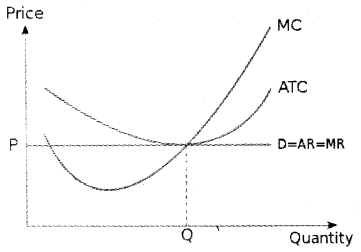
In the diagram the given price is P. Again the firm will produce the level of output for which MC = MR. This occurs at point E, giving a level of output of Q. Notice that at this point, AR = AC, so the firm is making normal profit.
So, in the short run, a perfectly competitive firm could be making super normal profit, or a loss, or just normal profit, depending on the given market price. Note that if the firm’s losses get too big in the short run (i.e. AR < AVC) then it will have to shut down.
Question 11. What are the conditions that are to be fulfilled for a firm to be in short run equillibrium under perfectly competitive market conditions? (MAY-2014)
Answer:
A firm is in equilibrium when it has no tendency to change its level of output. It needs neither expansion nor contraction. It wants to earn maximum profits. In the words of A. W. Stonier and D.C. Hague, “A firm will be in equilibrium when it is earning maximum money profits.” ’ Equilibrium of the firm can be analysed in both short- run and long-run periods. A firm can earn the maximum profits in the short run or may incur the minimum loss. But in the long run, it can earn only normal profit. Short-run Equilibrium of the Firm : The short run is a period of time in which the firm can vary its output by changing the variable factors of production in order to earn maximum profits or to incur minimum losses. The number of firms in the industry is fixed because neither the existing firms can leave nor new firms can enter it. It’s Conditions: The firm is in equilibrium when it is earning maximum profits as the difference between its total revenue and total cost. For this, it essential that it must satisfy two conditions:
(1) MC = MR, and
(2) the MC curve must cut the MR curve from below at the point of equality and then rise upwards. The price at which each firm sells its output is set by the market forces of demand and supply. Each firm will be able to sell as much as it chooses at that price. But due to competition, it will not be able to sell at all at a higher price than the market price. Thus the firm’s demand curve will be horizontal at that price so that P = AR = MR for the firm.
Marginal Revenue and Marginal Cost Approach : The short-run equilibrium of the firm can be explained with the help of the marginal analysis as well as with total cost-total revenue analysis. We first take the marginal analysis under identical cost conditions. This analysis is based on the following assumptions:
1) All firms in an industry use homogeneous factors of production.
2) Their costs are equal. Therefore, all cost curves are uniform.
3) They use homogeneous plants so that their SAC curves are equal.
4) All firms are of equal efficiency.
5) All firms sell their products at the same price determined by demand and supply of the industry so that the price of each firm is equal to AR = MR.
Determination of Equilibrium: Given these assumptions, suppose that price OP in the competitive market for the product of all the firms in the industry is determined by the equality of demand curve D and the supply curve S at point E in Figure 1 (A) so that their average revenue curve (AR) coincides with the marginal revenue curve (MR).
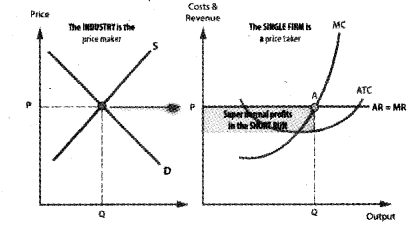
Question 12. A fruits seller sells 600 Kg. of grapes at market price of ₹40 per kg. When price increases to ₹50 per kg, he is ready to sell 750kg of grapes. Find out the price elasticity of supply. (MARCH-2015)
Answer:
Elasticity of supply
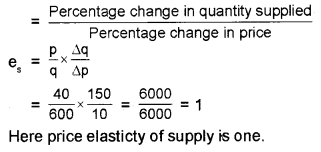
Question 13.
A firm that maximizes profit under perfect competition will not produce an output where (MARCH-2015)
(a) P > MC and
(b) P<MC.
If so, what is profit maximizing output condition in the short run? Briefly illustrate with diagram.
Answer:
A firm is in equilibrium when it has no tendency to change its level of output. It needs neither expansion nor contraction. It wants to earn maximum profits. In the words of A.W. Stonier and D.C. Hague, “A firm will be in equilibrium when it is earning maximum money profits.”
Equilibrium of the firm can be analysed in both short- run and long-run periods. A firm can earn the maximum profits in the short run or may incur the minimum loss. But in the long run, it can earn only normal profit.
Short-run Equilibrium of the Firm:
The short run is a period of time in which the firm can vary its output by changing the variable factors of production in order to earn maximum profits or to incur minimum losses. The number of firms in the industry is fixed because neither the existing firms can leave nor new firms can enter it.
It’s Conditions:
The firm is in equilibrium when it is earning maximum profits as the difference between its total revenue and total cost.
For this, it essential that it must satisfy two conditions:
(1) MC = MR, and
(2) the MC curve must cut the MR curve from below at the point of equality and then rise upwards.
The price at which each firm sells its output is set by the market forces of demand and supply. Each firm will be able to sell as much as it chooses at that price. But due to competition, it will not be able to sell at all at a higher price than the market price. Thus the firm’s demand curve will be horizontal at that price so that P = AR = MR for the firm.
1. Marginal Revenue and Marginal Cost Approach: The short-run equilibrium of the firm can be explained with the help of the marginal analysis as well as with total cost-total revenue analysis. We first take the marginal analysis under identical cost conditions. This analysis is based on the following assumptions:
1) All firms in an industry use homogeneous factors of production.
2) Their costs are equal. Therefore, all cost curves are uniform.
3) They use homogeneous plants so that their SAC curves are equal.
4) All firms are of equal efficiency.
5) All firms sell their products at the same price determined by demand and supply of the industry so that the price of each firm is equal to AR = MR.
Determination of Equilibrium:
Given these assumptions, suppose that price OP in the competitive market for the product of all the firms in the industry is determined by the equality of demand curve D and the supply curve S at point E in Figure 1(A) so that their average revenue curve (AR) coincides with the marginal revenue curve (MR).
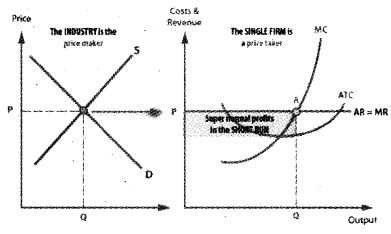
Question 14.
Will a profit-maximizing firm in a competitive market ever produce a positive level of output in the range where the marginal cost is falling? (MAY-2015)
Answer:
No, a profit maximising firm will not produce in the range where the marginal cost is falling. This is because, at this range, his profit is not maximised. So he fixes his level of out output at the point where marginal cost equals marginal revenue.
This can be explained with the help of a diagram.

As per the diagram, if the firm fixes output at the range where MC is falling his profit will not be maximised. Being profit maximising firm, he goes on producing OQ level of output corresponding to the point where MC=MR. This is at the rising part of MC. So his profit is maximised as shown in shaded area.
Question 15.
At the market price of ₹10, a firm supplies 4 units of output. The market price increases to ₹30. The price elasticity of the firm’s supply is 1.25. What quantity will the firm supply at the new price? (MAY-2015)
Answer:

Question 16.
Distinguish: (MARCH-2016)
a) Break even point
b) Shutdown point
Answer:
a) The point on the supply curve at which a firm earns
normal profit is called the break even point. The point of minimum average cost at which the supply curve cuts the LRAC curve is therefore the break even point of a firm.
b) In the short run the firm continues to produce as long as the price remains greater than or equal to the minimum of AVC. Therefore, along the supply curve as we move down, the last price-output combination at which the firm produces positive output is the point of minimum AVC where the SMC curve cuts the AVC curve. Below this, there will be no production. This point is called the short run shutdown point of the firm. In the long run, the shut down point is the minimum of LRAC curve.
Question 17.
Identify the wrong statements and correct the same. (MARCH-2016)
i) A perfectly competitive market deals in heterogeneous product.
ii) Each buyer Under perfect competition is a price taker.
iii) A perfectly competitive market is a market where there is only a single seller.
Answer:
i) Wrong. A perfectly competitive market deals with homogenous products
ii) Wrong. Each seller under perfect competition is a price taker.
iii) Wrong. A monopoly market is the market where there is only a single seller.
Question 18.
A firm under perfect competition wishes to maximize its profit in the short run. State and explain the conditions must hold for profit maximization. (MAY-2016)
Answer:
Perfect competition is a market situation where there are large number of buyers and sellers dealing with homogeneous commodities.
Conditions of equilibrium
i) MC = MR
ii) MC must cut MR from below It can be explained as,

Question 19.
Differentiate between the shut-down point and break even point. (MAY-2016)
Answer:
Shut down point refers to a situation where average revenue is equal to average variable cost. In other words it is the minimum pint of AVC. On the other hand, break even point is the no-profit, no loss point. It is the point where TR = TC or AR = AC.
Question 20.
Which one of the following condition is not satisfied by the long run equilibrium of a firm under perfect condition? (MARCH-2017)
a) P = AR
b) AR = MR
c) MC = MR
d) AFC = AVC
Answer:
AFC = AVC
Question 21.
Graphically explain the short run equilibrium of the firm under Perfect Competition. Draw separate diagram depicting the following conditions: (MARCH-2017)
i) The firm is earning super normal profit.
ii) The firm is earning only normal profit.
iii) The firm is incurring a loss
Answer:
The firm is earning super normal profit
Under perfect competition a firm’s super normal profit in the short run is maximised when 3 conditions are satisfied.
1) Market price P should be equal to marginal cost (MC) at equilibrium output q i.e, MC = MR = P
2) MC should be non-decreasing at Q, i.e. MC should cut MR from below.
3) P ≥ AVC
i) Since at point e AC curve touches AR curve, the firm enjoys normal profit only
ii) The firm is incurring a loss because of the free entry and exit of firms and buyers.
This can be explained with diagram.
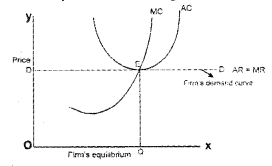
Profit maximization under short run graph
